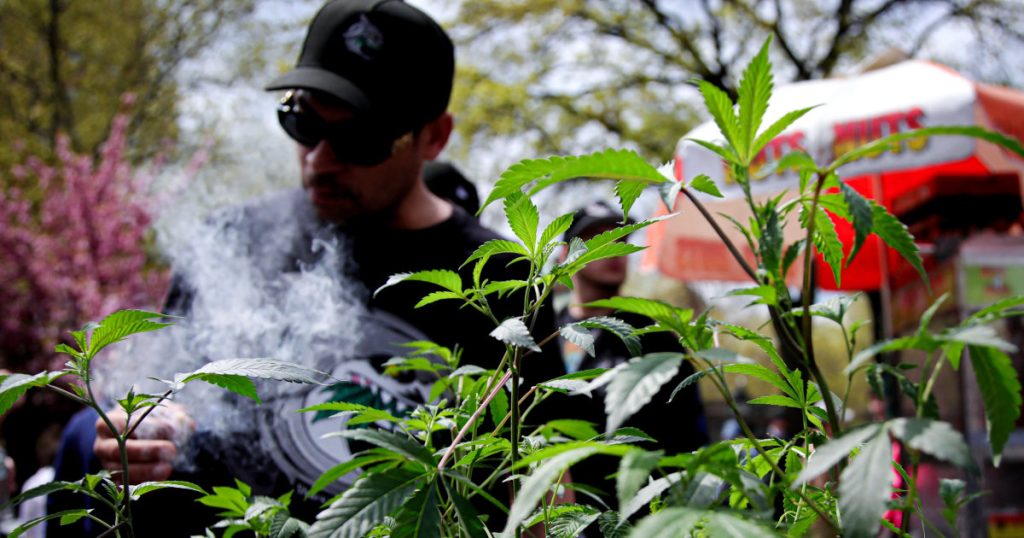Daily and near-daily marijuana use has become more common than similar levels of drinking in the United States, according to an analysis of national survey data spanning four decades. Research conducted by Jonathan Caulkins of Carnegie Mellon University reveals that while alcohol is still more widely used overall, 2022 marked the first time that intensive marijuana consumption surpassed high-frequency drinking. A significant 40% of current cannabis users are using it on a daily or near-daily basis, a pattern more akin to tobacco use than traditional alcohol consumption. The study, published in the journal Addiction, is based on data from the National Survey on Drug Use and Health, a reputable source of estimates on tobacco, alcohol, and drug usage in the country.
The analysis indicates that in 2022, approximately 17.7 million people engaged in daily or near-daily marijuana use, compared to 14.7 million individuals who reported daily or near-daily drinking. Over the span of three decades, the rate of individuals reporting frequent marijuana consumption increased by a factor of 15. This trend is reflective of evolving public policies surrounding cannabis, with most states now permitting medical or recreational marijuana use, despite its continued federal illegality. The upcoming referendum in Florida on a constitutional amendment to legalize recreational marijuana further underscores the changing landscape, along with potential federal reclassification of the drug as less harmful.
Dr. David A. Gorelick, a psychiatry professor at the University of Maryland School of Medicine, emphasizes that high-frequency marijuana use is associated with an elevated risk of addiction and other adverse effects. With more individuals engaging in daily marijuana consumption, the potential for problematic use and addiction is heightened. Gorelick also points out that frequent use increases the likelihood of developing cannabis-associated psychosis, a severe condition characterized by a detachment from reality. As such, the growing number of daily users signals a heightened public health concern regarding the potential negative impacts of high-frequency cannabis consumption.
The study’s findings shed light on the shifting patterns of substance use in the United States, with marijuana overtaking alcohol in terms of daily and near-daily consumption levels. This shift is notable given the well-established status of alcohol as the more widely used and socially accepted substance. The increase in daily marijuana users suggests a larger population at risk of developing substance use disorders or experiencing adverse outcomes associated with frequent cannabis consumption. As the legal landscape surrounding marijuana continues to evolve, it will be crucial for policymakers and healthcare professionals to address the implications of increased daily use on public health and individual well-being.
The research also underscores the importance of understanding the potential risks and consequences associated with high-frequency marijuana use, particularly in relation to addiction and mental health. As more individuals engage in daily or near-daily cannabis consumption, there is a greater need for targeted interventions and support services to address problematic use and prevent adverse outcomes. By raising awareness of the risks associated with frequent marijuana consumption, healthcare providers and policymakers can work to mitigate the potential negative impacts on individuals and communities. Additionally, ongoing research and monitoring of substance use patterns will be essential in informing evidence-based strategies to address the evolving landscape of substance use in the United States.
In conclusion, the study’s findings highlight the changing dynamics of substance use in the United States, with daily and near-daily marijuana consumption now surpassing similar levels of drinking. As public policies surrounding cannabis continue to evolve and more individuals engage in frequent marijuana use, there is a growing need to address the potential risks and consequences associated with high-frequency cannabis consumption. By understanding the implications of increased daily marijuana use and implementing targeted interventions, healthcare providers and policymakers can work to mitigate the negative impacts and protect public health. Ongoing research and monitoring will be crucial in shaping evidence-based strategies to address the evolving landscape of substance use and its impact on society.


